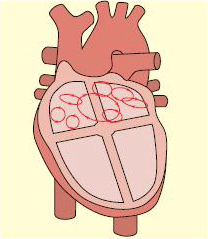Etiology
Coronary artery disease, hypertension, heart failure, valvular disease, diabetes, sepsis, chronic kidney disease, thyroid disorders, cardiac surgery, COPD, obstructive sleep apnea, sedentary lifestyle, and advanced age are known risk factors for the development of new-onset AF.[1][11][17][18][19][20][21][22] However, AF may occur in the absence of any underlying cardiac or noncardiac diseases: for example, as a result of heavy alcohol intake.[17][23][24][25]
Pathophysiology
The pathophysiology of AF involves multiple etiologies and complex electrophysiologic changes for which AF is the final common pathway.[1][17][26][27][28] The presence of rapidly firing foci, typically in the pulmonary veins, may trigger AF that is then sustained by the faltered electrophysiology of fibrosed and often dilated atria. Fibrosis and inflammation of atria causes a difference in the conduction properties and refractory periods within the atrial tissue and promotes electrical reentry that results in AF. The fractionation of a mother wave into multiple wavelets in the presence of enlarged atria in conjunction with the short refractory periods and slow conduction properties of the atria lead to sustained AF.[27][29][30]
[Figure caption and citation for the preceding image starts]: Multiple wavelets of atrial fibrillation compete with each other in the atrium and bombard the atrioventricular node with many signals.From: Cox D, Dougall H. Student BMJ. 2001;09:399-442 [Citation ends].
AF may also result as degeneration of other rapid arrhythmias, such as atrial tachycardia, atrial flutter, or atrioventricular (AV) nodal reentrant tachycardia and AV reentrant tachycardia. The latter occurs in the presence of congenital accessory bypass tract/s, either concealed or manifest (Wolff-Parkinson-White syndrome).[17][26][28]
Although higher ventricular rate from AF may cause an increase in the coronary flow, it may not be adequate to compensate for the increased myocardial oxygen demand that occurs as a result of irregularity in the ventricular rhythm.[31] Cardiac ischemia may thus develop even in patients without CAD, and this contributes to left ventricular dysfunction and subsequent symptoms of chest discomfort, dizziness, and shortness of breath.[31]
AF is associated with an increased risk of thromboembolism.[29] AF causes activation of the coagulation cascade, structural changes (both as cause and effect of AF) promote clot formation, and the loss of atrial systole leads to relative stagnation of blood.[32]
Classification
Classification and definition of AF subtypes
The practice guidelines for the management of patients with AF developed by the American College of Cardiology, the American Heart Association, the European Society of Cardiology, and the Heart Rhythm Society classify and define AF into the following types:[1][2][3]
Paroxysmal AF: AF that is recurrent (>1 episode ≥30 seconds in duration) and that terminates spontaneously or with intervention within 7 days.
Persistent AF: AF that is continuously sustained beyond 7 days, including episodes terminated by cardioversion after 7 days or longer.
Long-standing persistent AF: a subgroup of persistent AF, that is continuous for >1 year.
Permanent AF: AF that is refractory to cardioversion and sinus rhythm cannot be restored or maintained, such that AF is accepted as a final rhythm. A decision has been made by the patient and physician not to pursue restoration of sinus rhythm by any means, including catheter or surgical ablation.
Subclinical AF: the term subclinical AF usually represents asymptomatic episodes of AF detected either by cardiac implantable electronic devices or by cardiac monitors.
The following terms are no longer recommended:[1]
Nonvalvular AF: AF in the absence of rheumatic mitral stenosis, a mechanical or bioprosthetic heart valve, or mitral valve repair. The terms valvular/nonvalvular differentiate patients with AF in the presence/absence of moderate or severe mitral stenosis or a prosthetic heart valve. The European Society of Cardiology advises that this terminology may be confusing and should be avoided.[2]
Lone AF: the term "lone AF" applies to patients ages <60 years without echocardiographic or clinical evidence of cardiac, pulmonary, or circulatory disease. However, because definitions are variable, and all patients with AF have some form of pathophysiologic basis, the term “lone AF” is potentially confusing and should not be used.
Chronic AF: has variable definitions. For more information on chronic AF see Established atrial fibrillation.
Use of this content is subject to our disclaimer